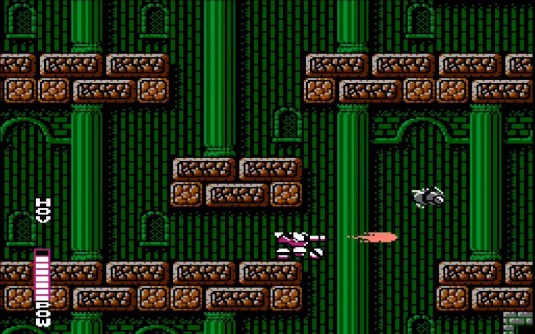
As you might imagine, platforming in a tank lends the game to some quite unusual features. And so it proves. The most stark of which are the two game modes. On the one hand there's your huge levels with plenty to discover and few hidden power ups to find, and then there's ... when you get out of the tank. Occasionally you come across small doors and gaps in levels too small for the tank. Here you press select and out you jump, a super deformed little man (supposedly Jason, a young lad in search of his radioactive frog as per the nonsense Western release plot). You enter the room et voila, the game switches to a pseudo-top down Zelda-style blaster. Not an addition many platformers can boast of, all told. Back in the tank, as you progress through the levels and after facing off against the end-of-level baddies, each victory awards your tank an upgrade. These include the ability to hover, shoot through destructible bricks, drive up walls and across ceilings ... all of these are needed to reach certain areas to advance the game. Further assistance comes in the form of weapons you can pick up through the level, which consist of homing missiles (essential!), bolts of lightning (only any good for enemies on the platform immediately underneath) and a multi-shot, which isn't so useful. Likewise, as you guide Jason through his overhead mazes you can acquire all kinds of power ups, which go from upgrades for your peashooter sidearm to bits and bobs for the tank.
What makes Blaster Master special can't be conveyed by drily describing the game's basics. For a lumbering tank you move with the kind of precision you'd find in a Mario game. With all the gizmos at your disposal and the hefty gun that comes as standard, it never feels underpowered or vulnerable, which - at least initially - tempts one to rush in without thinking about the next steps. With plenty of enemies flying about you almost feel compelled to try and take them out. As for the rest, you'll have to take me on trust or check out the multiple shrines on YouTube to the game. And yet there are certain features dedicated to drive the more casual gamer to distraction, especially those who are unused to retro titles and are dipping in.
First off, it is ridiculously hard, and in the unfair cheap ways NES games often are. Enemy placements on very tricky jumps are a nightmare, but particularly so in the overhead maps. Later on there are plenty of occasions where as soon as you enter a room there's an enemy there to sap your energy and, worse, bump down the power of your gun. Basically, on the higher levels unless your gun is at full power you can forget about making it through the maze of rooms, let alone taking on the boss. And also, like many NES games, you can't shoot straight when the gun is fully powered up. Instead of shooting a beam or bullets directly in front, we get instead a helix pattern of lasers. There's many an occasion where you have to be at an angle to take out a would-be assailant - if they're directly in front, forget it. And some of the bosses are ridiculous as well, especially the end of game nasty who not only takes an age to kill while you dodge endless bouncing balls, but you have a "bonus" boss to tackle as well. What jolly fun.
Also interesting are the changes Blaster Master underwent outside of Japan. As Nintendo were (still are) notoriously conservative, SunSoft pre-empted their family friendly expectations by toning down the sci-fi war theme and added the ludicrous frog plot - replete with cinematic introduction. The problem is our frog never appears in the game, nor is he rescued at the end. And when you're sat on your tank staring off into the distance on the ending screen, it seems you had the time to dye your hair from brown to blue. If you're going to localise, be sure of consistency ... though, to be honest, not many of the kids who purchased it back in the day would have completed it. So it's a moot point.
The classic qualities then lie in its originality: the two-game mode, the versatility and growing power of your tank, the unlocking of the levels as you become more able, and the general production values too. For a NES game the graphics are good (and the tank animations are very well done) and the music, I suppose, is fine if not too memorable for those whose appreciation of the game aren't framed by nostalgia goggles. But crucially, Blaster Master retains its status because nothing else like it emerged on the NES. Its mechanics, chiefly the dual mode, didn't receive tributes in many other if at all any platformers for the system, and the slow build of the tank's abilities was another mechanic seldom copied. There were sequels later for other systems that weren't terribly well recieved, but Blaster Master was a one-off. It stood out back in 1988. It stood out when it entered the European market. And 31 years after its release, it stands out now.
No comments:
Post a Comment